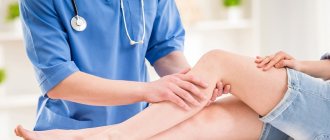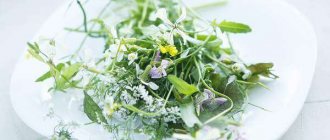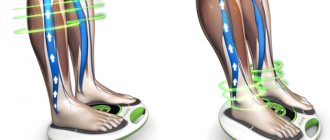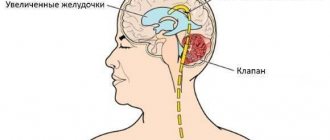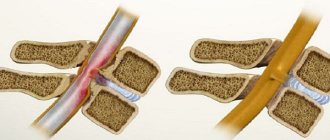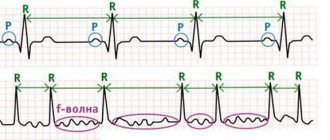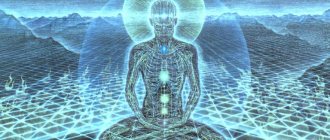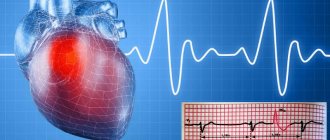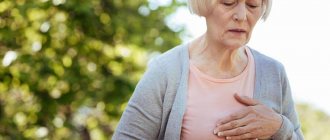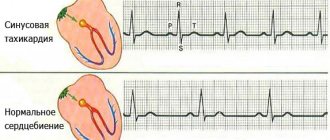If moderate or mild arrhythmia occurs, home treatment is possible, using medications, physiotherapy or traditional methods. For more severe arrhythmia, therapy is carried out in a hospital setting, which helps to avoid life-threatening conditions.
Arrhythmia is a rhythm disorder in which a rapid heartbeat develops and the rhythm is lost. The heart rate can be 120 beats/min or more, and symptoms such as dizziness, decreased performance, palpitations, and a feeling of interruptions in the heart may appear.
The presence of arrhythmia should not be ignored, since this condition can provoke the development of more severe complications: ischemia, heart attack, angina pectoris, dystrophic pathologies.
Correct treatment of arrhythmia can only be prescribed if a complete examination of the patient has been carried out. For this purpose, electrocardiography, cardiac ultrasound, Holter monitoring, and stress tests are used. If there are concomitant diseases, clinical tests are performed, and hereditary pathological conditions are screened.
How to relieve an attack of arrhythmia at home
Possible causes, risk factors
If we consider all existing cardiac pathologies, the share accounted for by various types of heart rhythm disturbances is impressive. Approximately 10% of people over 60 years of age show signs of arrhythmia, and the prevalence of such diseases among men is one and a half times higher than among women.
Children and adolescents are less susceptible to diseases associated with changes in heart rate: the proportion of sick children is 0.6%.
Disruption of the processes of the myocardial conduction system occurs due to improper formation of electrical signals or failures in the process of their conduction to different areas. As a result, the current jumps to the next node in the chain, so the rhythm gets lost.
Reasons for violations
The described disorder occurs due to the presence of cardiac pathologies or negative manifestations of an internal or external nature.
Pathology is caused by the following heart diseases:
- Cardiomyopathy,
- Heart attacks,
- Ischemic disease
- Atherosclerosis of the coronary vessels,
- Heart defects (especially in children),
- Dystrophy and other myocardial anomalies.
Also, heart rate disturbances can be caused by such phenomena as:
- Diseases of internal organs,
- Vegetovascular dystonia,
- Obesity,
- Hormonal imbalance
- Pathologies of the nervous, endocrine system,
- Poisoning, drug overdose, intoxication,
- Severe stress, emotional distress,
- Anemia,
- electric shock,
- Anesthesia,
- Surgical operations.
At-risk groups
The main factors that can cause various types of pathological changes in the rhythm of contractions are:
- Excessive drinking,
- Smoking,
- Regular infectious diseases
- Mental, physical stress,
- Excessive consumption of energy drinks, caffeine,
- Incorrect medication intake
- Genetic factors (heredity),
- Aged people.
In rare cases, spontaneous arrhythmia is observed, characteristic of people with a quick temper. Why is this variety dangerous? In cases of serious anxiety, patients complain of an irregular heartbeat immediately after the excitement passes.
Is it possible to get rid of arrhythmia completely?
Arrhythmia is one of those diseases that may prevent you from breathing calmly. This is due to the fact that some patients, during a deep breath or even while yawning, feel a sharp jolt in the heart area, which precisely indicates the presence of a rhythm disturbance. That is why people with this disease are so actively looking for an answer to the question “How to get rid of arrhythmia.
Arrhythmia can be asymptomatic, but sometimes it manifests itself very clearly, with hemodynamic disorder and a sharp deterioration in the patient’s condition.
Depending on the form of arrhythmia and the severity of symptoms, treatment of the disease is carried out. The earlier it is started, the greater the likelihood that it will be possible to get rid of arrhythmia almost once and for all. Existing methods for eliminating arrhythmia will be discussed in more detail.
Video An Israeli doctor told how to get rid of heart arrhythmia forever
Types of arrhythmia
To classify, diseases should be divided into several groups according to the location of the malfunction.
- Malfunction of the sinus node.
- The sinus type is characterized by an abnormal rate of contraction, is common in people under 30 years of age, and often occurs during heavy physical exertion.
- Sinus tachycardia is an increased heart rate.
- Sinus bradycardia is a slow heartbeat.
- Atrial asystole is a total suppression of the functioning of the sinus node.
- Failures in myocardial conduction function or inflammatory processes within this area.
- Blockades in different departments (slowing or stopping the transmission of impulses).
- Excitation of the ventricles too early.
- Simultaneous failures of the processes of conduction, automaticity, excitability.
- Rapid flutter of the ventricles or atria.
- Extrasystole is characterized by the presence of premature contractions.
- Atrial fibrillation, ventricular fibrillation - irregular frequency of contractions.
In addition to the listed diseases, there are other forms caused by the combination of several pathological factors.
A separate group should include functional rhythm disorders, which include:
- Disorders of neurogenic origin. The functioning of the heart is directly influenced by the nervous system, which controls the functioning of all internal organs. The nervous system is a branched network of sympathetic and parasympathetic nerves that influence the heart muscle in different directions. Increased tone of the vagus (parasympathetic) nerve slows down the rhythm of contractions, and the sympathetic nervous system, with increased tone, increases the heart rate. The reasons for the activation of sympathetic tone are stress, experiencing strong emotions, mental and physical overload, frequent smoking, excessive consumption of alcoholic beverages, large amounts of caffeine per day, spicy, fatty foods. In addition, sympathetic tone increases in the presence of thyroid diseases, as well as intoxication and blood diseases. There are vagodependent arrhythmias that occur mainly at night, when the activity of the parasympathetic system increases. The causes of increased tone can be various diseases of the gastrointestinal tract.
- Diselectrolytes cause altered blood composition or the content of chemical elements in the heart muscle (potassium, magnesium levels).
- Iatrogenic types occur due to improper treatment.
- Mechanical ones are provoked by injuries to the sternum, falls from great heights, and electric shock.
- Idiopathic arrhythmias is a term for abnormal heartbeats for which no cause has been identified.
Pediatric arrhythmia
A separate topic is heartbeat disorders in children. They can be congenital or acquired.
The first type occurs while the baby is in the womb, so the task of doctors leading the pregnancy is to regularly listen to the fetal heartbeat. Why does it occur? The main reason is genetic predisposition.
Young children are sensitive to any negative events that cause them strong emotional stress. Frequent scandals between parents and other events that affect the baby’s psyche can cause the development of cardiac diseases.
New technologies from the field of surgery
Radical treatment is one of the ways to permanently recover from arrhythmia. The method involves ablation of a lesion located in the heart muscle and generating extraordinary impulses. To perform the procedure, special catheters are used, which are led through the femoral vein to the chambers of the heart. With their help, the pathological focus is first identified, and then its destruction is carried out.
During radiofrequency ablation, physical methods such as laser, ultrasound, and cold can be used. The most effective and high-quality minimally invasive intervention is guaranteed with the use of high-frequency electricity.
The operation is most often performed as planned, after examining the patient and consulting with specialist doctors. It is mainly prescribed for arrhythmias such as atrial fibrillation, atrial flutter, atrioventricular and supraventricular tachycardia, and ventricular dysfunction. It takes from 1.5 to 6 hours. It all depends on the difficulty of finding the ectopic focus. The faster it can be identified using a diagnostic catheter, the faster its destruction is carried out, which, in fact, ends the main stage of catheter ablation.
Symptoms
Since this is a complex of diseases with different characteristics, their symptoms also differ from each other. Let's look at the symptoms of the most common manifestations:
- With sinus tachycardia, an increase in heart rate of 90 beats/min and above is observed. The patient reports shortness of breath, increased fatigue, palpitations, and a feeling of weakness throughout the body.
- In the case of paroxysmal tachycardia, the correct rhythm is traced, but at the same time it is more rapid - from 140 beats per minute. A patient with arrhythmia complains of profuse sweating, weakness, and frequent urination. With a prolonged attack, chest pain appears, even to the point of fainting.
- Sinus bradycardia is characterized by a contraction frequency of 55 beats per minute or lower. Symptoms include low blood pressure, a feeling of weakness, slight dizziness, and “aching” pain in the heart area.
- Symptoms of the sinus type are slow contractions when inhaling and rapid contractions when exhaling. This disease is common among teenagers and women during pregnancy.
- Extrasystole is difficult to diagnose, since the patient usually does not feel any changes in the body. A rare patient may notice a slight increase in the impulse to the heart muscle, which immediately freezes.
- With atrial fibrillation, the ventricles of the heart contract at a rate of up to 150 beats/min, which is a sign of severe heart defects, causing severe pain in the chest, insufficient pulse compared to the frequency of contractions, as well as an irregular heart tone.
- Signs of fluttering of different parts of the heart or their blockade may include such phenomena as cardiac arrest, fainting, thready pulse, convulsions, interruptions in breathing, dilated pupils.
As you can see, the specific symptoms are completely dependent on the species. The list of classification of symptoms is determined by the type of disease, but sometimes arrhythmia is practically asymptomatic, so prevention plays a key role in the fight against the disease.
Let's look at the most common symptoms inherent in different types in more detail.
Increased SS rhythm
A heart rate exceeding 90 beats/min is considered pathologically high. This is a recognized clinical sign of a large group of tachycardias. Often, a rapid heartbeat is accompanied by a feeling of weakness, heavy sweating, and slight shortness of breath. The highest heart rate is considered to be 180 beats in 60 seconds - this is a serious danger to the patient’s life.
Increased heart rate is usually caused by a cold, anemia, high blood pressure, exercise, excessive caffeine consumption, and frequent smoking.
If this indicator is detected, you should undergo electrocardiography and other examination methods. If a stable, frequent rhythm above 100 beats is observed, the doctor determines tachycardia and prescribes appropriate treatment.
Slow SS rhythm
This symptom is not a clinical sign of cardiac pathology, since it is quite often observed in completely healthy people, especially in old age. Bradycardia is dangerous along with such phenomena as dizziness, loss of consciousness, dark spots before the eyes. If the listed ailments are absent, treatment is not required.
Chest pain
Sometimes the pain occurs due to muscle spasms caused by overeating or intense exercise. However, pain in the heart area, which is accompanied by an increase in heart rate and does not stop for a sufficiently long period of time, can be a consequence of a violation of the normal function of the heart muscle. Then you need to call an ambulance and ensure complete rest for the patient.
Loss of consciousness
Practical diagnosis of the cause of fainting is a difficult task. This symptom is characteristic not only of arrhythmia, but also of other pathologies: strong emotional shocks, taking medications, problems with the cardiovascular system. An attack of tachycardia or bradycardia often leads to loss of consciousness, since these types of arrhythmic heartbeat provoke a decrease in cardiac output and an excessive decrease in blood pressure.
Fainting is a short-term period of loss of consciousness, which manifests itself as a person falling to the floor. The main cause of fainting is an interruption in blood supply to the brain. Before fainting, people experience increased sweating, a feeling of nausea, and palpitations. You should be concerned if this symptom recurs frequently - you need to see a doctor to get an ECG.
Dizziness
Usually this sign of arrhythmia is accompanied by a feeling of muscle weakness, nausea, and sweating. Dizziness can also be caused by cervical osteochondrosis and vegetative-vascular dystonia, so for an accurate diagnosis it is necessary to undergo a special examination.
Physiotherapy
Dosed and properly distributed physical activity can improve the functioning of the heart and normalize its functioning.
It is important to take into account that independent selection of a set of exercises may not only not lead to the expected result, but also aggravate the disease.
In this regard, it is advisable to consult a doctor who will analyze the characteristics of the body, take into account possible contraindications and draw up a special exercise schedule.
When determining an algorithm for physical therapy, a specialist can identify the following contraindications to gymnastics:
- blockage of veins in the legs;
- severe heart failure;
- liver function failure;
- endocrine disorders.
Exercise therapy for arrhythmia
One of the simplest types of physical therapy is breathing exercises. Such exercises can prevent heart rhythm disturbances and prevent the progression of the disease. They not only contribute to the health of the body, but also normalize blood circulation. The following exercises are recommended for people prone to heart disease:
- Take the starting position (standing, feet shoulder-width apart). Inhale and squat down, keeping your heels on the floor. Turn to the left and rise as you exhale. Repeat again, but make a right turn. Alternate turns while keeping your hands on your waist.
- Take a sitting position, bend your elbows, palms away from you. Inhale through your nose and slowly exhale through your mouth. As you exhale, clench your palms into fists.
Diagnostics
As it became clear from the previous part of the article, the clinical manifestations of the disease are quite diverse and numerous, so making a diagnosis requires several studies at once.
If you identify the above-described signs, you should contact a specialist in such diseases - a cardiologist. The doctor will conduct an examination, prescribe an examination of the heart and blood vessels based on the patient’s complaints to determine the cause, and make prognoses for the near future.
The main methods for diagnosing arrhythmias are listening to the heartbeat, electrocardiography, and echocardiography.
- Electrocardiography allows, through the use of electrodes installed on the surface of the chest, to obtain data on heart rhythm, the presence of ischemia, and residual effects from past diseases. Interpretation of the resulting ECG serves to identify atrial fibrillation.
- Echocardiography uses the properties of ultrasound to assess the condition of the parts of the heart and their functioning. The doctor will be able to measure the size of the sections, determine the thickness of the myocardium, and identify various pathologies.
For irregular manifestations of symptoms, Holter monitoring is used, which consists of round-the-clock monitoring of the heartbeat through sensors, performed on a stationary basis. The purpose of monitoring is to identify daily attacks of atrial fibrillation, assess the correctness of sinus rhythm restoration, and determine the average heart rate.
In situations where the signs of the disease cannot be identified using the listed methods, the doctor may prescribe provoking procedures:
- Tilt test. It is carried out on a rotary table in the laboratory, subject to comfortable conditions and strict safety precautions (resuscitation methods have been prepared).
- A treadmill test is a special test with physical activity (an exercise bike or treadmill), during which an ECG is performed, the pulse, blood pressure, and general well-being of the patient are monitored. Used in the absence of regular attacks in order to correct the course of treatment.
- Stimulation through the esophagus.
- Invasive examination (electrophysiology) using thin catheters.
The doctor may also prescribe a general and biochemical blood test, each of which performs separate functions. General analysis reveals inflammatory processes, and biochemistry detects hyperlipidemia - elevated levels of cholesterol, electrolytes or liver enzymes, which is important when prescribing drugs.
Drug treatment is one of the options to get rid of arrhythmia
Cardiac arrhythmia can also be eliminated with medications. This method is most often used in hospitals and clinics. Drugs are selected from various groups of action, mainly antiarrhythmic drugs. Their appointment is indicated when the patient has a clinical disease that threatens hemodynamic changes. The most well-known arrhythmic drugs today are amiodarone and propafenone.
It is strictly not recommended to independently select the dose and take antiarrhythmic drugs. If used incorrectly, the drugs can cause a sharp decrease in blood pressure and even cardiac arrest.
If the patient’s condition worsens while taking arrhythmic drugs, then other treatment methods are used, among which today the dominant place is given to radiofrequency ablation.
First aid for an attack
What should you do if you or a loved one has a seizure?
If an attack occurs for the first time, it is necessary to call an ambulance, since it is almost impossible to independently determine the type of illness and choose a method of assistance.
- While waiting for an ambulance, you need to lie down and ask relatives to ventilate the room, but if you have shortness of breath, it is recommended to maintain a semi-sitting position. Often, changing the position from sitting to lying down and vice versa allows you to relieve the manifestations of arrhythmia, along with this, breathing exercises and inducing vomiting can help.
- Doctors advise taking 40 drops of Corvalol, one tablespoon of valerian or motherwort.
- To suppress a panic attack, you need to enlist the support of loved ones.
- Some patients benefit from manual therapy. You need to close your eyes and gently press on your eyelids with your fingers every three seconds.
If the pulse drops, you need to tilt the patient's head back to open the airways, then loosen the collar of the clothes. In case of fainting, it is necessary to perform a chest massage and perform artificial respiration on the patient.
In what cases can arrhythmia not be managed without medical help?
Arrhythmia is never a variant of the physiological norm. The only exception is an accelerated heart rate, which returns to normal after stopping the exercise. In other cases, it is a disease or syndrome that requires treatment.
There are types of arrhythmias that cannot be dealt with on your own; medical care is required, and often hospitalization. The most dangerous conditions include atrial fibrillation, ventricular tachycardia, and bradycardia below 40 beats per minute. They do not appear by chance; they are caused by serious pathologies of the heart, blood vessels, thyroid gland and other diseases.
Cases when you should not try to do without an ambulance:
- the attack dragged on;
- there was severe chest pain;
- there was a feeling of lack of air;
- dizziness and weakness appeared.
As a result of such an attack, thrombosis may begin with unpredictable consequences.
Treatment at home
Some types of arrhythmia, such as chronic ventricular tachycardia and atrial fibrillation, pose a threat to the patient’s life, so they require constant therapy and treatment with folk remedies. Unfortunately, existing methods of drug treatment can only relieve the patient from attacks of the disease, and complete relief often requires surgical intervention.
Medicines
Antiarrhythmic drugs for the described disease are dispensed from pharmacies with a prescription from a cardiologist. Depending on the tablet, the heart muscle has different effects: some prolong the rhythm of contractions, others speed it up.
The most common medications are trimecaine, disoperamide, quinidine, lidocaine, etacizine, metoprolol, atenolol, amiodarone, verapamil.
- For sinus tachycardia, beta-blockers are prescribed along with sedatives and vitamins.
- The diagnosis of “sinus bradycardia” will require the use of vasodilating drugs (for example, Actovegin, aminophylline and others).
- For extrasystole, atropine-type medications, herbal infusions are prescribed, and potassium supplements are often prescribed. If attacks occur regularly, the patient is admitted to a hospital and treated with a course of lidocaine and other procedures.
- In case of atrial fibrillation, digoxin, electric pulse treatment, as well as anticoagulants along with potassium supplements are prescribed to improve the patient’s condition. Often the only treatment option is surgery.
- Ventricular flutter requires an injection of lidocaine or potassium chloride. In case of cardiac arrest, urgent defibrillation or surgery is performed.
Anticoagulants have a number of contraindications, so many patients are advised to agree to surgery or the installation of a pacemaker.
Folk remedies
Arrhythmia is one of the phenomena in which doctors recommend resorting to traditional recipes, since they can complement and enhance the effect of taking medications. How to treat arrhythmia using traditional recipes?
The main components of most herbal infusions and infusions are plants that have a sedative effect on the body: valerian, motherwort, hawthorn.
If there are heart rhythm disturbances, it is necessary to pay attention to the underlying disease that disrupts the normal functioning of the heart: cardiosclerosis, myocarditis, neurosis, etc.
Traditional medicine contains dozens of recipes to alleviate symptoms and restore normal heartbeat. Which ones are most effective? We present a list of the most popular options, the use of which is not only not dangerous, but, on the contrary, is very useful for heart patients. At least, the positive reviews from patients on the forums speak for themselves.
- Pour boiling water (half a liter) over dried calendula flowers (a couple of teaspoons) and let it brew for about two hours. Take half a glass of solution four times a day.
- A collection of yarrow, hop cones, valerian root, lemon balm in a ratio of 2:2:3:3. Pour 200 ml of boiling water over a tablespoon of this mixture, leave for 1 hour, then strain. Drink 50 ml four times a day.
- Pour 2 teaspoons of dried cornflower flowers with a glass of boiling water, let it brew for 60 minutes. Drink 60-70 ml 4 times a day.
- Take equal parts of strawberry leaves, sweet clover herb, rose hips, hawthorn fruits, calendula flowers, chicory root, asparagus roots, peppermint, mix. An infusion is prepared from one tablespoon of the collection and 300 ml of boiling water overnight. You need to take 100 ml every 4 hours.
- The procedure for preparing the previous infusion is suitable for a mixture of equal parts of fennel fruits, rose hips, honey leaves, watch leaves, strawberries, foxgloves, wild rosemary.
- Another infusion using a similar technology is prepared from a mixture with the following ingredients: meadow clover, yarrow, apple peel, watch leaves, fennel fruits, strawberries, valerian (equal parts).
- Pour 30 g of dried belozer grass into 500 ml of vodka, leave for two weeks, shaking regularly, then strain the resulting liquid, take 30 drops four times a day.
- Infusion of European sage and vodka in a ratio of 1:5 (stand for 6 days), take 10 drops 3 times a day.
- Pour 120g of pine tops with 500 ml of vodka and leave in daylight for 10 days. Take 20 drops 3 times a day, before meals.
- For high blood pressure, you should take a remedy of 1 tablespoon of any honey with 100 ml of beet juice 3 times a day.
- If you have a racing heart, you can eat figs.
- If you have arrhythmia of atherosclerotic origin, it is useful to make a salad from a mixture of fresh onions and apple pulp.
Aromatherapy can also help you fight attacks at home. Mix equal amounts of clove, lemon balm, pine, lavender, nutmeg, sage, thyme, anise, eucalyptus oils, pour the resulting mixture into the aroma lamp, inhale after the next attack.
Infusions of valerian, hawthorn, mint, lemon balm can be added to baths, or teas can be brewed with these herbs.
Treatment of cardiac arrhythmia with folk remedies
Traditional medicine also has in its arsenal many recipes for combating arrhythmia - this is the help of medicinal herbs and mixtures.
Herbs
An infusion of pansies gives an excellent result - just steam 2 tsp in a glass of boiling water. dried color and leave for about 2-3 hours. Take 1-2 tbsp 3-5 times throughout the day. l.
Oxalis, or more precisely, its inflorescences, also shows good treatment results - a tablespoon of dried raw material is steamed in a glass of boiling water and left for an hour. Allow to cool to room temperature and drink as tea.
Asparagus is not just a side dish, but also a medicinal plant. Not only young shoots are taken as medicine, but also the rhizome - they are finely chopped and steamed in boiling water. Infuse for 2-3 hours and, after straining, drink in small sips throughout the day - the maximum dosage is no more than a glass per day.
Hawthorn - its inflorescences and fruits are brewed as tea or added to herbal preparations. It is enough to take 1-2 tbsp per 500 ml of boiling water. l. raw materials, leave for half an hour and drink as tea.
Fragrant celery 500 gr., 50 gr. parsley and 30 grams of propolis - the mixture is steamed with 2 liters of boiling water and left for 24 hours. Take this infusion - no more than a glass a day.
Medicinal mixtures
Combination of onion and apple.
Take 1 pc. apples and onions, peel and chop, mix with each other - take 1 tsp of this mixture. twice a day for a month. Salad – celery and parsley, dill and sour cream. Tasty and simple - it contains a lot of useful vitamins that strengthen the heart.
Aromatic mixture - grate half a kilogram of lemon fruits, add 500 grams to the mixture. honey and 20 crushed apricot kernels. Mix everything and take a teaspoon before meals in the morning and evening.
Juices are also an excellent remedy for treating arrhythmia, especially if you combine several types of them in one glass. A mixture of beet, radish and carrot juices in equal proportions helps restore normal heart function.
Dried fruits – 200 gr. dried apricots, raisins and walnuts, which are poured with 200 ml of liquid honey and the juice of 1-2 lemons is added. Mix everything and store it in the refrigerator - take a tablespoon after meals three times a day.
Preventive measures
Since various types of arrhythmia are life-threatening and can increase the risk of blood clots, prevention of such diseases is indicated for all patients, even with irregular symptoms.
The main goal of preventive measures is to prevent sudden death from an attack. According to statistics, approximately 40% of deaths occurred in people who had never experienced a seizure before. Therefore, even feeling normal, the absence of obvious symptoms is not a guarantee that you are an absolutely healthy person.
Nutrition
The key to good health for people with heart palpitations is proper nutrition. When planning your daily diet, it is recommended to choose foods high in potassium and magnesium, which have a positive effect on the heart muscle. When selecting products, you need to take into account that some magnesium-rich foods (seeds, nuts, cereals) contain calcium and phosphorus, which significantly reduce the positive effect of magnesium.
The daily need for magnesium and potassium increases with severe physical activity and stress, as well as with active intellectual work and digestive disorders.
Prevention is a mandatory component in the presence of diseases such as diabetes, gastritis, ulcers, problems with the pancreas, and diseases of the endocrine system.
Potassium-rich foods:
- Vegetables (carrots, potatoes, cabbage);
- Cereals (buckwheat, oatmeal, millet);
- Dried fruits;
- Nuts.
Magnesium-rich foods:
- Sea kale;
- Cocoa;
- Bran;
- Dried apricots;
- Beans;
- Shrimps;
- Nuts;
- Buckwheat honey;
- Sesame;
- Peas.
You should reduce your consumption of fatty foods and concentrate on vegetables, fruits, and grains. You should not overeat, especially in the afternoon, because an overfilled stomach can cause irritation of the parasympathetic nerve, which threatens the normal functioning of the sinus node.
Do not underestimate the beneficial effects of vitamins on the body suffering from arrhythmia. Since one of the common causes of heart rhythm disturbances is general weakness of the body, vitamins will come in handy. It is recommended to eat more fresh berries and fruits, and also take multivitamin complexes that saturate the body with useful microelements.
How to get rid of atrial fibrillation forever?
The next episode of the “Medicine in Israel” program is dedicated to the treatment of atrial fibrillation. The host of the program, Dr. Victor Levy, asked questions to the invited guest, associate professor of the department at Tel Aviv University, head of the department for the treatment of atrial fibrillation at Sheba Hospital, David Lurie.
Tell us in a nutshell what cardiac arrhythmia is?
From the name of the pathology it is clear that arrhythmia is a violation of the heart rhythm. A heart rate that is too fast is called tachycardia, and a heart rate that is too slow is called bradycardia. These disorders can threaten a person's health and therefore require treatment.
Why is atrial fibrillation dangerous?
Atrial fibrillation is a common disease. In America alone, this problem has affected more than 4 million people; I think there are no fewer such patients in Russia. This disease disrupts a person’s normal lifestyle, interferes with walking, causes shortness of breath, palpitations, but also threatens with serious complications, such as heart failure and the formation of blood clots in the vestibule of the heart, which can cause ischemia and stroke.
Previously, symptoms of arrhythmia were treated with Coumadin (warfarin). This drug is known to have a number of serious side effects. Are there new, safer treatments for arrhythmia?
At the moment, serious progress has been made in arrhythmology. In recent years, fundamentally new non-drug approaches to the treatment of atrial fibrillation have developed. It is known that arrhythmia develops in certain areas of the atrium. If these lesions are reached by cardiac catheterization and removed by ablation, the arrhythmia can be completely cured, thereby eliminating the need for long-term medication. The catheter required for this procedure is inserted into a vein in the leg. The effectiveness of ablation in the treatment of paroxysmal arrhythmia is 80%.
Not all patients can be treated with arrhythmia using ablation. In patients with chronic arrhythmia, heart defects, and other serious heart conditions, sometimes the arrhythmia cannot be cured. In their case, a second non-drug approach to preventing thromboembolic complications is used. It consists in the fact that the area of the atrium, which we call the left atrial appendage, where blood clots form, is closed with a special umbrella - an occluder. It is also administered through the leg using a catheter. Isolation of the thrombogenic zone reduces the risk of blood clot formation and associated stroke by 10-20 times.
Is this procedure as effective as Coumadin?
She's taller. Studies have shown that over the course of a year, the ratio of side effects to therapeutic benefits of installing an occluder and taking Coumadin is approximately the same. However, over time, if the patient continues to take the drug, the risk of side effects increases.
Doctor, I accidentally learned that you recently received a patient from Kazakhstan with a heart attack. During the examination, he was diagnosed with arrhythmia. The patient was very surprised when he learned that arrhythmia could be treated with something other than pills. Tell us more about this case.
Yes, this is a really interesting case. This young active man is a representative of a new category of arrhythmia patients. Previously, this disease was the privilege of older people. In recent years, for unknown reasons, arrhythmia has become sharply younger. In Kazakhstan, they could not offer the patient anything other than drug treatment, which, as we know, only alleviates the patient’s condition, but does not cure the disease. That is why a new approach was developed - ablation. At the moment it is widely used in Israel and Europe, and is just beginning to be used in Russia. We recommended this operation to the patient and he was very glad to be able to forget about the arrhythmia forever.
How difficult and dangerous is “cauterization” for arrhythmia?
Despite the fact that “cauterization” sounds scary to the average person, the procedure actually involves pinpoint burns. The procedure is painless, although it is performed under anesthesia. The operation is technically complex, but not for doctors with extensive experience. The average procedure time is two and a half hours. Because the surgery is minimally invasive, there is no recovery period required, but we typically keep patients hospitalized for one night.
Is there an age limit for ablation?
No, but the younger the patient, the higher the effectiveness of the operation. The risk of serious disabling complications is minimal, and bleeding may occur in only 1-2% of cases. This complication is quickly diagnosed and in 99% of cases does not cause any long-term consequences. This problem is solved by repeating the procedure.
Nutrition correction - start of therapy
Diet has been proven to affect heart rate. By adding or eliminating certain foods to the menu, you can normalize your heart rate.
What should be excluded from the diet for people suffering from attacks of tachycardia:
- coffee and tea, especially strongly brewed;
- alcoholic drinks;
- hot spices;
- smoked and canned products;
- mushrooms;
- foods high in fat, especially animal fat;
- dishes prepared by frying;
- salty foods;
- confectionery;
- chocolate, cocoa.
An important rule of nutrition for tachycardia is frequent meals in small portions. It is forbidden to eat at night; fatty foods in large quantities are especially contraindicated. Food should be prepared by steaming, boiling, stewing or baking.
Herbal medicine is perhaps the first thing that comes to mind when we mention traditional medicine. On the Internet and in print, you can now easily find a lot of recipes for herbal remedies, the use of which supposedly will quickly and completely relieve you of any arrhythmia.
How to help yourself during an attack?
The following actions will help ease the attack and partially or completely normalize the rhythm:
- sit down comfortably and lie down so that the head end is slightly raised:
- take a sedative - Corvalol, Valocardin, motherwort tincture;
- use reflex correction of heart rhythm.
There are several methods of reflex correction, all of them are based on stimulation of the vagus (vagus nerve):
- Light finger pressure on the eyeballs. Apply pressure, hold for a few seconds and release. Repeat several times.
- On the sides of the neck near the larynx there are carotid sinuses (where the carotid artery expands). Massaging these points can normalize the rhythm. However, this method is unacceptable for people suffering from atherosclerosis. During the massage, a sclerotic plaque can come off and cause an ischemic stroke.
- You can massage your solar plexus with your fist. This method will only help people with a normal physique. In obese patients it is impossible to reach the nerve plexus.
- Holding your breath as you exhale will slow down your heart rate due to the saturation of the blood with carbon dioxide.
- For atrial fibrillation, straining while inhaling is considered the most effective.
- Stimulation of the gag reflex.
If the condition does not improve after 30 minutes, you need to call an ambulance.
"Aromatic" treatment
You can get rid of arrhythmia using aromatherapy. Essential oils of eucalyptus, cinnamon, lemon balm, mint, anise, thyme, sage, pine or fir, cloves and nutmeg will help. Knowing your tendency to arrhythmia, you should always keep any of them at hand. During an attack, you need to apply 5 drops of ether to a cloth and inhale the aroma alternately through each nostril,
Delicious treatment
Treatment of atrial fibrillation with folk remedies as a condition that threatens the patient’s life can only be used in combination with drug therapy and with constant supervision by the attending physician.
Among the remedies used to relieve the symptom of increased heart rate, take herbal and fruit infusions, as well as infusions and mixtures of food products.
Folk remedies for the treatment of atrial fibrillation, despite the large number of synthetic drugs with proven effectiveness, are still of interest and are supported by positive reviews on the Internet.
Non-traditional methods of treatment cannot replace clinically proven remedies used for therapeutic and prophylactic purposes.
Substantiation of the weak and unproven effectiveness of traditional methods of treating arrhythmia.
The possibility of curing arrhythmias with herbs should be critically considered, because this disorder in almost all cases only complicates the course of the underlying pathology, and is not an independent nosological entity. Therefore, single-component drugs are, as a rule, ineffective for cardiovascular diseases.
It is necessary to evaluate the potential danger of side effects of herbal medicines. Plants contain hundreds of biochemical ingredients, the effects of which on the body in isolation and in combination have not been studied.
In addition, the composition of raw materials is often unstable due to soil variability, ecological balance of the collection area, etc. The advantage of synthetic drugs is the consistency of the substance and precise dosage.
In addition, herbal preparations carry a potential risk for certain categories of patients in terms of unpredictable allergic reactions.
Conducted studies indicate that if complex herbal preparations in small and medium doses in the treatment of arrhythmias show a certain pharmacotherapeutic effect, then exceeding the volume causes the opposite effect.
Only a qualified herbalist can determine the individual optimal dosage. It is extremely difficult to do this yourself at home.
Honey mixtures for the treatment of CVD are used to lower blood lipids and restore protein balance in myocardial cells. However, in large quantities, honey causes a feeling of euphoria in the patient. As a result, the patient does not evaluate his condition critically, aggravating the course of cardiovascular pathologies.
Successful cases of bee stings in the treatment of arrhythmias have been described, but the effectiveness of this method is offset by the high allergic risk for the patient.
You can treat tachycardia at home in a tasty way. How to do it?
Arrhythmia should be treated by a cardiologist. But everyone needs to know what first aid should be. If this is your first attack of arrhythmia, you must urgently call an ambulance, since it is quite difficult to independently diagnose arrhythmia and distinguish it from other problems.
The patient must be put to bed, reassured, and provided with sufficient fresh air. If there is shortness of breath, the optimal position is semi-sitting.
A person’s well-being largely depends on the health of the cardiovascular system. Arrhythmia is a certain malfunction in the stable functioning of the heart and blood vessels, the manifestation of which should not be ignored.
Treatment of this pathology should be carried out not only with medications, but also with traditional methods, which significantly increase the healing process for arrhythmia.
What is cardiac arrhythmia: causes, types, symptoms ^
Arrhythmia is a pathological condition characterized by disturbances in the rhythm, frequency and contraction of the heart. Causes of arrhythmia:
- Damage to the heart muscle (heart attack, cardiosclerosis, myocarditis);
- Changes in the content of magnesium, calcium and potassium in the blood;
- Chronic lung diseases, heart failure;
- Stress, neuroses, long-term depression;
- Damage to the central nervous system;
- Long-term exposure to toxins.
Symptoms of cardiac arrhythmia include palpitations, dizziness, fainting (rarely), headaches and shortness of breath. The following methods are used to diagnose arrhythmia:
- ECG study;
- ECHO – cardiographic examination;
- Intracardiac electrophysiological study.
Cardiac arrhythmia is divided into the following types - atrial fibrillation, sinus, extrasystolic, paroxysmal, ventricular, monotopic, polytopic and atrial.
Traditional treatment for arrhythmia mainly consists of medicinal plants, herbs, roots, bee products, freshly squeezed juices, medicinal berries and other herbal remedies.
Treatment of arrhythmia at home, in combination with a course prescribed by a doctor, helps create the best environment for the heart to work, significantly improving its supply with oxygen, blood, potassium and calcium ions. In addition, complex therapy has a positive effect on the nervous system, normalizes blood pressure, heart rate and rhythm.
Heart rhythm disturbances are a concern for many people, and their severity can vary. You need to know how to normalize your condition and prevent negative consequences, in particular for those who suffer from a problem such as arrhythmia.
What it is?
Arrhythmia is not an independent disease, but most often a symptom of various pathologies. Sometimes it may not be associated with serious problems, but sometimes it may indicate serious disorders of the cardiovascular system. But regardless of the severity, measures must be taken to prevent the problem from developing.
There is a misconception that arrhythmia involves erratic contraction of the heart muscle. But experts use this term for any disturbances of cardiac activity - both a decrease and an increase in heart rate.
As for the treatment of arrhythmia, there are a huge number of all kinds of medications, however, treatment with folk remedies can be much more effective, and in addition, even safer! We suggest that you adopt several recipes with which you can prepare medicine to treat arrhythmia at home.
The presence of atrial fibrillation can be confirmed or refuted using an ECG and ultrasound. You will have to take a general and biochemical blood and urine test.
To eliminate arrhythmia, doctors prescribe drugs that reduce the heart rate. Most often they are beta-blockers.
Treatment of arrhythmia is carried out using:
- drugs that control heart contractions (Verapamil);
- medications that normalize heart rhythm (Sotalol, Propanorm);
- drugs whose action is aimed at thinning the blood and preventing thrombosis (Prodax, Warfarin).
For intravenous administration use:
- Novocainomide;
- Quinidine;
- Panangin;
- Aymalin.
If there is no result from drug treatment, patients under 60 years of age undergo surgical operations: pacemaker implantation and catheter ablation.
To alleviate their condition with arrhythmia, patients must follow a diet, the main condition of which is to consume as much fluid as possible. It is recommended to include the following products in the diet:
- grape and cranberry juice;
- barley, buckwheat and oatmeal;
- peas and beans;
- bananas;
- watermelons and melons;
- cucumbers;
- walnuts and almonds;
- green and herbal tea.
There is a wide variety of recipes for mixtures of various food components. Some recipes make you wonder: why is such a drug needed for arrhythmia? There is no answer.
The most useful advice here is to eat foods rich in potassium, sodium, and magnesium. They help restore normal levels and ratios of electrolytes in the body and can help treat arrhythmias.
You can prepare and regularly consume a mixture of chopped dried fruits and nuts. As for other methods, it is better to first consult a doctor before using them.
Breathing procedures for arrhythmia
Treatment with folk remedies also includes breathing exercises. This is an effective method of prevention, but due to certain stresses on the cardiac system, you should consult a doctor before starting exercises.
Breathing procedures allow you to change your heart rate. Such changes have a beneficial effect on the autonomic system, which directly affects the functioning of the lungs and heart.
Due to the fact that blood circulation is significantly improved, the required amount of oxygen enters the heart muscle and the contraction rhythm is normalized. This is one of the most effective methods for countering arrhythmia at home. By combining it with other methods, you can achieve impressive results.
Exercise "pump"
The “pump” exercise allows you to quickly eliminate an attack; it is considered as first aid for arrhythmia:
- sit on the edge of the bed (you can use a chair), resting your palms on your knees; the head should be lowered;
- Bend your body slightly forward;
- inhalations should occur through the mouth;
- exhale slowly while straightening your back (do not lean back).
The duration of one exercise is 20–30 minutes, they should be done in the morning and evening (twice a day).
